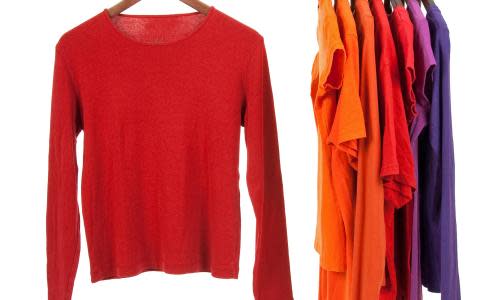Your polyester sweater is destroying the environment. Here's why

Last week, an exclusive Guardian report revealed that a mind-boggling 13.3 quadrillion microfibers (infinitesimal strands of fabric) were released into the California environment in 2019.
Related: Bottle-fed babies swallow millions of microplastics a day, study finds
All fabrics release microfibers, whether they are organic, like hemp and wool, or synthetic, like polyester and acrylic. Since their discovery in 2011 by ecologist Mark Browne, much of the conversation surrounding microfibers has focused on synthetic fibers in particular. That’s because, as a product of the petrochemical industry, synthetic fabric is essentially plastic, making the microfibers it releases a form of microplastic pollution. As the California study suggests, plastic microfibers are a disturbingly abundant foreign substance in the Earth’s ecosystem – they make up 90% of the microplastic pollution in the Atlantic Ocean, and are easily ingested by the tiny fish and plankton that support the entire marine ecosystem.
While larger pieces of plastic garbage in the ocean are largely attributed to poor waste management in rapidly developing economies, microfiber pollution is predominantly linked to wastewater from developed nations, according to an article recently published by the American Association of Textile Chemists and Colorists. Clothing releases the most microfibers while being machine-washed, and many of those fibers elude filtration in treatment centers, ultimately ending up in waterways and oceans. One study from 2017 even found that 83% of global tap water samples contained microfibers.
So, is the solution to stop buying synthetic clothing?
“Shifting away from synthetic fabrics is one way to reduce microplastics in the ocean,” says Dr David Hunt, a biological oceanographer at the University of British Columbia. “Decreasing the demand for synthetics would decrease production.”
Recently, some retailers have marketed “anti-microbial” or “anti-odor” clothing they claim requires only infrequent washing; Hunt considers such initiatives, as well as a movement among eco-conscious consumers to buy more organic, natural fabrics, generally encouraging.
“But still,” he says, “there’s the question of: what happens with these new approaches? Everything we do has some kind of effect. Even with natural clothing, depending on how it’s treated, there might be some contributions to pollution in the ocean.”
Wool and cotton may be chemically processed; they also require much water and energy to produce. Buying lots of fancy new environmentally friendly gear is still less sustainable than sticking with what you already have. In the same sense, boycotting polyester is good, but let’s not forget the problem of microfibers is amplified by the amount of clothing we’re producing and buying on a macro level.
Fashion corporations must be held accountable for implementing sustainable practices across their supply chains
The emergence of fast fashion in the early 2000s introduced consumers to cheaply made, often synthetic clothing on a massive scale. A growing middle class has helped clothing production double in the last 15 years, according to the Ellen McArthur Foundation, an environmental charity; the global clothing industry is estimated to grow from $1.9tn in 2019 to over $3tn by 2030. Textile production is the world’s second-most polluting industry, behind only oil – and every year we prematurely discard $400bn worth of clothing.
Fashion corporations must be held accountable for implementing sustainable practices across their supply chains, including developing and using sustainable fabrics that do not emit microplastics. On a consumer level, we need to ensure the trend of resale continues its encouraging trajectory by shopping thrift and vintage, renting trendy and special occasion-wear, and consigning or donating our used clothing. We can also wash our clothing less frequently and in cold, quick cycles - this reduces microfiber shedding, and helps retain the clothes’ quality, too.
Did you know that you can often recycle old clothing almost the same way you recycle bottles and cans? In many places you can bring old clothes to specific textile recycling depots or sign up for a free recycling program. In 2018, a Hong Kong textile mill even pioneered a technology which recycles waste textiles into new yarn on an unprecedented scale. The technology caught the interest of fast-fashion giants like H&M.
With effort and innovation, microfiber pollution – among the other environmental ills caused by the fashion industry at large – can be reduced. As for the quadrillions of fibers the fabrics all around you are shedding: think of them the next time you catch yourself impulse shopping for a new outfit, and perhaps take a minute to reflect on whether you have enough, already.
Legendary Watergate reporter Bob Woodward will discuss the Trump presidency at a Guardian Live online event on Tuesday 27 October, 7pm GMT. Book tickets here

 Yahoo News
Yahoo News 